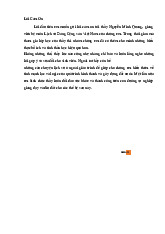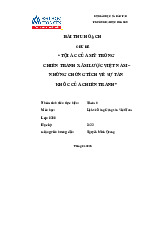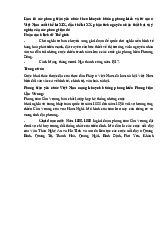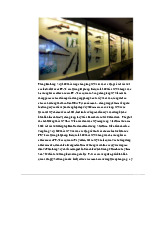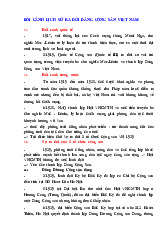











Preview text:
1. Which of the following is not a barrier to supply chain management?
a. all of the above and/or below are barriers
2.The supply chain management concept originated in what discipline? a. logistics
3. The supply chain management concept originated in what discipline? a. logistics
4. What is a fourth-party logistics provider?
d. a company that ensures that various third-party logistics companies are
working toward the relevant supply chain goals and objectives
5. The general idea behind is that one company allows a specialist company to
provide it with one or more logistics functions.
a. third-party logistics
6. What concept refers to "how well company resources are used to achieve
what a company promises it can do?" c. Efficiency
7. The most costly logistics activity in many firms is
d. transportation management
8. The primary objective of supply chain management is to fulfill through the
most efficient use of resources, including distribution capacity, inventory and labor. a. customer's needs
9. What concept refers to "how well company resources are used to achieve
what a company promises it can do?" d. Efficiency
10. Which of the following is not a barrier to supply chain management?
a. all of the above and/or below are barriers
11. The most costly logistics activity in many firms is
a. transportation management
12. The general idea behindis that one company allows a specialist company to
provide it with one or more logistics functions
d. third-party logistics
13. With respect to the supplier selection and evaluation process, looks at both
the internal and external environment within which the supply decision is to be made. b. situation analysis
14. Which concept refers to the storage of finished product and movement to the customer?
c. physical distribution
15. The movement and storage of materials into a firm refers to:
d. materials management
16. The supply chain management concept originated in what discipline? d. logistics
17. What concept can be viewed as a combination of processes, functions,
activities, relationships, and pathways along which products, services,
information, and financial transactions move in and between enterprises from
original producer to ultimate end user or consumer? d. supply chain
18. What concept can be viewed as a combination of processes, functions,
activities, relationships, and pathways along which products, services,
information, and financial transactions move in and between enterprises from
original producer to ultimate end user or consumer? a. supply chain
19. The general idea behind allows a specialist company to provide it with one or more logistics functions. a. multichannel marketing
b. third-party logistics c. supply chain management
d. cross-organizational collaboration
20. The most costly logistics activity in many firms is a. warehousing management
b. transportation management c. industrial packaging d. order management
21. The movement and storage of materials into firm refers to: a. supply chain management b. physical distribution
c. materials management d. materials handling
22. The primary objective of supply chain . through the management is to fulfill
most efficient use of resources, including distribution capacity, inventory and labor. a. manufacturer's needs b. customer's needs c. supplier's needs
d. All the above and/on below options ar correct.
23. The supply chain management concept originated in what discipline? a. logistics b. marketing c. operations d. production
24. What concept can be viewed as a combination of processes, functions,
activities, relationships, and pathways along which products, services,
information, and financial transactions move in and between enterprises from
original producer to ultimate end user or consumer?
a. interorganizational coordination b. logistics c. marking channel d. supply chain
25. With respect to the supplier selection and evaluation process, looks at both
the internal and external environment within which the supply decision is to be made. a. evaluate suppliers b. situation analysis c. identify suppliers
d. identify the need for supply
26. What concept refers to "how well company resources are used to achieve
what a company promises it can do?" a. Reengineering b. Productivity c. Effectiveness d. Efficiency
27. What is a fourth-party logistics provider?
a. a company that ensures that various third-party logistics companies are
working toward the relevant supply chain goals and objectives
b. a logistics intermediary that specializes in one logistics activity such as warehousing or transportation
c. a third-party logistics provider that been in existence for at least 25 years
d. a third-party logistics provider that has achieved ISO 9000 cerfcation
28. Which concept refers to the storage of finished product and movement to the customer? a. business logistics
b. physical distribution c. materials management d. supply chain management
29. Which of the following is not a barrier to supply chain management?
a. reluctance to share, or use, relevant data
b. all of the above and/or below ar barriers
c. lack of top management commitment
d. regulatory and political considerations
30. _____refers to the removal of intermediaries between producer and consumer a. direct channels b. market demassification c. disintermediation d. consolidation
31. _______usually specialize in warehousing and transportation services that
can be customized to customers' needs based on market conditions and delivery
service requirements for their products and materials.
a. Second-party logistics providers
b. Fourth-party logistics providers
c. Third-party logistics providers
d. First-party logistics providers
32. Logistics clearly contributes to ______ and _______ utility a. place: form b. possession; time c. time; place d. form: time
33. The movement and storage of materials into firm refers to: a. physical distribution b. materials handling
c. materials management d. supply chain management
34. Supply chain activities natural resources, raw materials and components
into a finished product that is delivered to the end customer. a. pass b. transform c. change d. move
35. ____involves the activities of receiving storing, and distributing raw
materials for use in production. It is an integral element of business operations for a manufacturing firm. a. Reverse Logistics b. Outbound Logistics
c. None of the above and/or below is correct d. Inbound Logistics
36. The most costly logistics activity in many firms is_____ a. order management
b. transportation management c. industrial packaging d. warehousing management
37. Which concept refers to the storage of finished product and movement to the customer? a. supply chain management b. business logistics c. materials management
d. physical distribution
38. ______ refers to having products available where they are needed by customers. a. Possession b. Place c. Time d. Form
39. ______is the process related to the storage and ovement of the final product
and the related information flows from the end of the production line to the end user a. Reverse Logistics
b. All the above and/or below options are correct c. Outbound Logistics d. Inbound Logistics
40. The supply chain management concept originated in what discipline? a. logistics b. production c. marketing d. operations
41. The primary objective of supply chain through the management is to
fulfill______ through the most efficient use of resources, including distribution
capacity, inventory and labor. a. manufacturer's needs
b. All the above and/on below options are correct. c. customer's needs d. supplier's needs
42. The general idea behind ____ is that one company allows a specialist
company to provide it with one or more logistics functions. a. supply chain management
b. cross-organizational collaboration c. multichannel marketing
d. third-party logistics
43. What concept refers to "how well company resources are used to achieve
what a company promises it can do?" a. Efficiency b. Productivity c. Reengineering d. Effectiveness
44. The movement and storage of materials into a firm refers to: a. materials handling
b. materials management c. supply chain management d. physical distribution
45. _____refers to being out of an item at the same time there is demand for it. a. stockout b. intensive distribution c. tailored logistics d. supplier indifference
46. Which concept refers to the storage of finished product and movement to the customer? a. materials management b. business logistics
c. physical distribution d. supply chain management
47. What concept can be viewed as a combination of processes, functions,
activities, relationships, and pathways along which products, services,
information, and financial transactions move in and between enterprises from
original producer to ultimate end user or consumer? a. marking channel b. supply chain c. logistics
d. interorganizational coordination
48. The supply chain management concept originated in what discipline? a. logistics b. marketing c. operations d. production
49. Which concept refers to the storage of finished product and movement to the customer?
